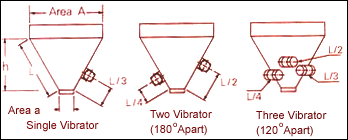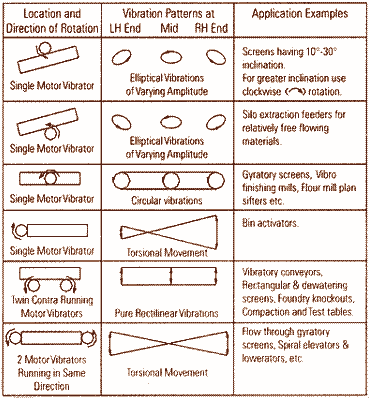Importance of vibrator selection need not be over emphasized. However good a range of vibrators available may be, unless a right model is chosen and applied correctly, no good and efficient results can be obtained. Therefore we, Sinex Prime movers present below at your, our valued customers' disposal, all the data, information and experience gathered during our over a decade long working on this subject.
Industrial uses of motor vibrators could be categorized into two types based on amplitudes involved ; (1) Tremors - micron level vibrations and (2) Large oscillations, in several millimeters. The former are encountered in silo and bin discharge applications and promoting material flow down chutes, ducts etc. while the later are found in equipment such as feeders, conveyors, spiral elevators, screens, vibratory tables etc.
Vibrator Selection for Bin, Hopper & Silo Discharge Application :Years of experience and data collection have shown that force applied to bin walls should be 10 to 20% of material weight in the lower convergent part for satisfactory activation, dechoking and discharge.
Figure-1: Positioning Vibrators for Material Discharging
Taking into consideration the above in conjunction with bin sizes and wall thickness recommendations are tabulated at Table-2 to facility easy selection. Since tremors are at high frequencies it is appropriate to use 3000 rpm vibrators hence recommended force values correspond to this speed.
Table-2 : Vibrator Force values for Bin, Hopper & Silo Discharge| Bin Wall Thickness up to | Bin dia./ diagonal up to | Material Weight to be activated Kg.s |
Recommended Vibrator Force
in Newtons
|
Remarks | ||
| Single | Two | Three | ||||
| 2 | 450 560 700 |
25 40 70 |
400 560 900 |
500 | Use Pneumatic Turbine Vibrators | |
| 3.2 | 630 800 1000 |
50 100 200 |
1000 1600 2500 |
1250 | Pneumatic Piston Vibrators may also be considered | |
| 5 | 900 1100 1400 |
150 270 550 |
2800 3600 4500 |
1800 2250 |
1600 | |
| 6.3 | 1250 1600 2000 |
400 825 1600 |
4500 5600 7100 |
3200 4000 |
2750 | For difficult to flow materials & to gate uniform discharge other flow aids like Bin activator etc. may be considered |
| 8 | 1800 2250 2800 |
1200 2300 4500 |
7100 9600 |
5600 7100 |
5000 | |
| 10 | 2500 3200 4000 |
3200 6400 12500 |
12500 16000 |
8000 10000 12500 |
7100 9000 |
|
The above assumes material bulk density of 800 Kg s / cu.mt., bin walls not heavily stiffened and discharge openings not too small, which as a rule should be largest practically feasible. Forces may be varied in direct proportion to densities and in cubic to wall thickness.
Location of vibrators on storage vessel is very important from the view point of obtaining reliable discharge with minimum detrimental effect of brute force on the bin structure. Recommendations in this regards based on experience are shown in Figure-1
Selection For Equipment Employing Large Amplitudes:Here selection involves deciding on type of vibrations required to carry out process, number of vibrators to be used and their placement on driven machinery.
a) Vibration Types :Could be Circular or elliptical or rectilinear or torsion. Adjoining Table-3 explains how different vibrations are obtained by different placement of vibrators vis-à-vis the machine
This would help users decide on number and location/s of vibrator/s on driven machinery so as to obtain most suitable vibrators to accomplish a process.

b) Choice of Vibration Frequency, Amplitude and Acceleration:
These are again decided by the process to be carried out. The Table-4 bellow shall provide a valuable guidance for deciding at least a range of these parameters.
As a thumb rule; (I) for small and light equipment weighing 15-150 Kgs requiring up to 3 mm amplitude it could be 50 Hz, (ii) for medium sized in 50-500 Kgs weight range requiring upto 6 mm amplitude it could be 25 Hz and (iii) relatively large and heavy equipment weighing 400-4000 Kgs with amplitudes up to 12 mm it could be 16 Hz. Frequencies could be still lower for heavier machines having longer strokes.
c) Vibrator Sizing:
Upon having determined (I) peak to peak amplitude ('A' in mm), (ii) total live & dead mass including estimated weight of vibro motors/s to be used( 'W' in Kg. s), (iii) vibration frequency/ rpm ('N' per minute) and (iv) number of vibro motors used to drive ('n').
d) Vibration isolation Suspension Design
A very important part of vibration machinery and having great bearing on its efficient working is the suspension. It should allow free oscillations and prevent harmful transmission of vibrations to the surrounding. Generally 95% isolation is satisfactory in industrial environment and can be obtained by using resilient mounting having following static deflection 'd' under the weight of vibrating parts.
In the Event any assistance is required from us, Sinex Primemovers, in selecting suitable vibro motor/s to drive machinery, please furnish details of your applications such as (i) live & dead weight to be vibrated (ii) amplitude desired, (iii) frequency most suited for the process, (iv) damping factor present (v) purpose to be achieved, (vi) material details etc. along with a drawing / sketch of machine / systems to enable us work out and submit optimum recommendation.
